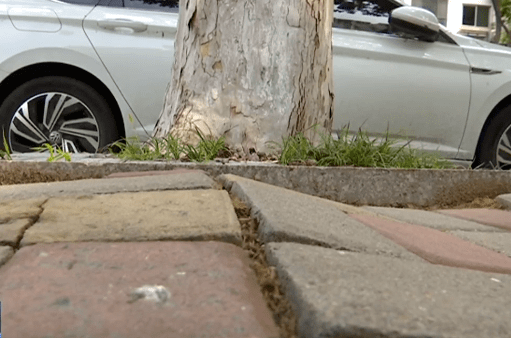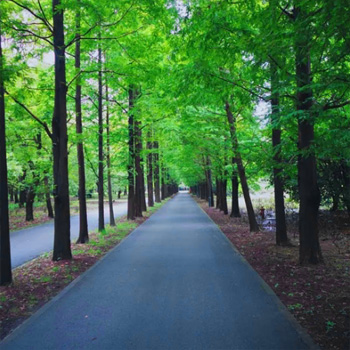During the construction of modern cities, people often plants tree along the sides of the road to enhance the environment and make fresh air. However, after a long period, people discover that trees can also cause damage to the environment.
Tree root causes damage to road surface
Workers lifted up the marble that was “squeezed” by the roots of the camphor tree on one side of the damaged road, and leveled the surrounding ground. They also laid mortar, and re-laid marble.
In recent days, the city’s construction department has carried out repairs on the roads in the urban area. The roads around the tree pool that have been damaged by tree roots have been listed as the main content of the repairs to ensure the city’s environment and the safety of citizens’ travel.

Trees and roads are “competing”
Many places are subject to repairing
Workers were renovating the tree pool and said “The width of the new tree pool is 2.2 meters, which is much wider than the tree pools in other places, and it is more conducive to the growth of large trees.”
A worker told reporters that in the past, the tree pool was small, and the camphor in it grew faster, and the trees cannot bear the pressure that the ground brings. The oppression of the bricks on the ground made the road surface look bad and became an obstacle for citizens to pass. Therefore, to improve the road environment, the construction department decided to expand the area of the tree pool to create more space for the growth of trees.
On the sidewalk in front of an education institution in the city center, the “fierce” camphor will bind its marble top to a height of about 20 centimeters, and the curbs are crooked. The marble and curbs opened their “big mouths”. The reporter saw that similar problems appeared on the ground under several camphor trees. And two workers are repairing the damaged road.
Citizens found that more than half of the original marble pavement around the camphor trees was raised. Some places “grinning their teeth”, and some places were extensively damaged. The impact of the above tree roots is only limited to the surrounding area of the tree pool. The sidewalk is damaged by the tree roots. It causes the road surface undulating and rough.
Mr. Liu, a citizen, said that because of the uneven road surface due to the growth of tree roots, pedestrians bump into bumps when passing, and are prone to tripping and injury on the uneven road surface, especially for the elderly with handicapped legs. It is suggested that when selecting street tree species, relevant departments should carefully select tree species in consideration of whether they will affect the road surface in the later stage of growth. Ms. Wang, a citizen, told the reporter that the sidewalks are not spacious in the first place. When planting trees, you must have a sense of foresight, dig the tree pit a little deeper, leave as much space as possible for the roots of the trees, or plant green trees with underdeveloped root systems.
Expert’s suggestion
Solving this problem early in the design process
The root of the street tree will damage the sidewalk, which is not conducive to the growth of the tree, but also increases the danger of walking. As a result, both sides will lose.
Planning experts believe that as far as the existing trees are concerned, with the growth of street trees, the contradiction between tree roots and tree pools will exist for a long time. From the perspective of design and maintenance, to avoid or reduce the damage to sidewalk pavement caused by the root growth of street trees, we must first pay attention to the selection of tree species. The degree of damage to roads varies greatly between different tree species. Trees such as sycamore and camphor are more destructive. The destructiveness of trees such as Magnolia is relatively mild. When designing road greening, street trees should be selected according to the type of root system of the tree species.
Insufficient embedding depth of tree roots is more likely to cause damage to the sidewalk by the root system, and it is also prone to wind blowing to cause trees to fall, so when planting street trees, be sure to reach a sufficient depth. In addition, the size of the tree pool should not be too small. If possible, you can consider setting up a continuous tree pool, which is both beautiful and leaves sufficient space for the growth of plant roots. It is best to start with planning, plan a green belt of a certain width outside the sidewalk, and plant street trees in the green belt.
According to the analysis of greening experts from the Urban Housing and Urban-rural Development Bureau, the root system of the tree grows larger and larger. And the base of the root system of the tree may be a roadbed, which cannot expand downward, so it has to bulge upward. The expert believes that the solution to this problem is to leave enough space for the roots of trees to develop.
HOSNSOEY Cells can solve this problem, and provide enough space for tree root growth:
— Transfer water from the ground to the bottom of the tree root system to realize sufficient irrigation;
— Guide the root system to grow downward;
— The HOENSOEY CELL on the surface creates space, so the root system will not grow upwards;
–Comprehensive benefits: Trees can grow healthily without artificial irrigation and the road surface will not be damaged so as to realize the sustainable beautification of urban landscape with low consumption.


